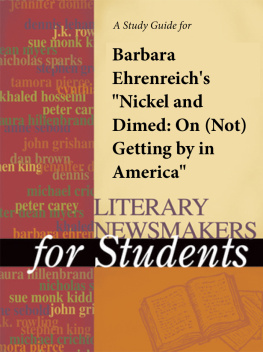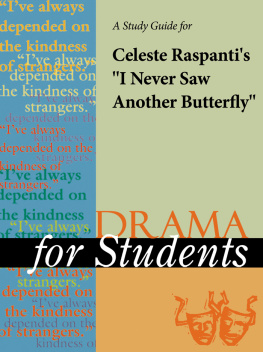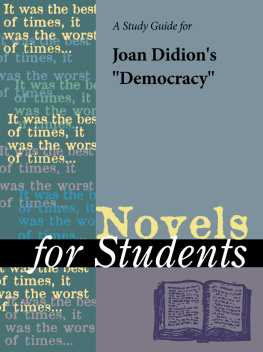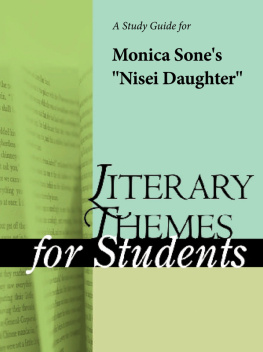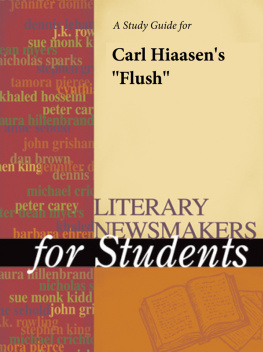TABLE OF CONTENTS
Guide
Literary Newsmakers for Students, Volume 1
Project Editor: Anne Marie Hacht
Editorial: Sara Constantakis and Ira Mark Milne
Rights Acquisition and Management: Margaret Chamberlain-Gaston and Sue Rudolph
Manufacturing: Drew Kalasky
Imaging: Lezlie Light, Mike Logusz, and Kelly Quin
Product Design: Pamela A. E. Galbreath
Vendor Administration: Civie Green
Product Manager: Meggin Condino
2006 Gale, a part of Cengage Learning Inc.
Cengage and Burst Logo are trademarks and Gale is a registered trademark used herein under license.
For more information, contact
Gale, an imprint of Cengage Learning
27500 Drake Rd.
Farmington Hills, MI 48331-3535
Or you can visit our internet site at http://www.gale.com
ALL RIGHTS RESERVED
No part of this work covered by the copyright herein may be reproduced or used in any form or by any meansgraphic, electronic, or mechanical, including photocopying, recording, taping, Web distribution, or information storage retrieval systemswithout the written permission of the publisher.
For permission to use material from the product, submit your request via the Web at http://www.gale-edit.com/permissions, or you may download our Permissions Request form and submit your request by fax or mail to:
Permissions Department
Gale, an imprint of Cengage Learning
27500 Drake Rd.
Farmington Hills, MI 48331-3535
Permissions Hotline:
248-699-8006 or 800-877-4253, ext. 8006
Fax: 248-699-8074 or 800-762-4058
Since this page cannot legibly accommodate all copyright notices, the acknowledgments constitute an extension of the copyright notice.
While every effort has been made to secure permission to reprint material and to ensure the reliability of the information presented in this publication, Gale, an imprint of Cengage Learning neither guarantees the accuracy of the data contained herein nor assumes any responsibility for errors, omissions or discrepancies. Gale, an imprint of Cengage Learning accepts no payment for listing; and inclusion in the publication of any organization, agency, institution, publication, service, or individual does not imply endorsement of the editors or publisher. Errors brought to the attention of the publisher and verified to the satisfaction of the publisher will be corrected in future editions.
ISBN 1414402813
ISSN 1559-9639
Printed in the United States of America
10 9 8 7 6 5 4 3 2 1
Nickel and Dimed: On (Not) Getting by in America
Barbara Ehrenreich
2001
Introduction
When one is charged a little bit at a time until the expense grows beyond expectations, that is called being "nickel and dimed." In 2001's Nickel and Dimed: On (Not) Getting By in America, essayist and social critic Barbara Ehrenreich applies this notion to minimum-wage workers. She argues that their spirit and dignity are chipped away by a culture that allows unjust and unlivable working conditions, which results in their becoming a de facto, or actual without being official, servant class. Spurred on by recent welfare reforms and the growing phenomenon of the working poor in the United States, Ehrenreich poses a hypothetical question of daily concern to many Americans: how difficult is it to live on a minimum-wage job? For the lower class, what does it take to match the income one earns to the expenses one must pay?
Rather than simply listen to other people's accounts, Ehrenreich herself assumes the role of a minimum-wage worker. In different states and in several different jobs, she attempts three times to live for one month at minimum wage, giving up her middle-class comforts to experience the overlooked hardships of a large sector of America. While she freely admits that hers is an unusual situation, she stresses it is also a best-case scenario; others face many more difficulties in their daily lives, such as the lack of available transportation. Due to an accessible style and subject matter, Nickel and Dimed became a bestseller that helped restart dialogue on the current state of American work, American values, and the consequences of letting a national emergency remain unacknowledged for too long.
Author Biography
Though Barbara Ehrenreich is best known for her 2001 investigation of the working poor, Nickel and Dimed: On (Not) Getting by in America, her career as a journalist and social critic spans three decades.
Barbara Alexander was born August 26, 1941 in Butte, Montana, the daughter of New Deal Democrats. (The New Deal was legislation presented by President Roosevelt in the wake of the Great Depression. It was based on the idea that the government should intervene to help stabilize the economy.) She earned a bachelor's degree in chemical physics from Reed College in 1964 and a Ph.D. in cell biology at Rockefeller University. While at Rockefeller, she met her first husband, John Ehrenreich, and became involved in both the antiwar movement and the cause for improving health care for low-income families. This led to two collaborations between the Ehrenreichs: Long March, Short Spring: The Student Uprising at Home and Abroad (1969) and The American Health Empire: Power, Profits, and Politics, a Report from the Health Policy Advisory Center (1971). With Deirdre English, she wrote two more books on health care and one about advice literature, For Her Own Good: One Hundred Fifty Years of the Experts' Advice on Women (1978). With husband John, she wrote the influential essay "The Professional-Managerial Class," which explored the importance of having left-leaning, or liberal, middle-class intellectuals work with the traditional left of the lower-income working class. She would return to this topic in 1989's Fear of Falling: The Inner Life of the Middle Class, examining the professional-managerial class's retreat from liberalism (political ideal that the purpose of government is to ensure individual liberties) and the growing rift between classes.
As the conservative Reagan era ushered in the 1980s, Ehrenreich maintained a vigorous liberal perspective while breaking into mainstream media, contributing to the New York Times since 1983 and writing a regular column for Time from 1991 to 1997. Her concerns about feminism, class, and social injustice were expressed in such books as The Hearts of Men: American Dreams and the Flight from Commitment (1983), and Re-making Love: The Feminization of Sex (1986). In the 1990s, Ehrenreich wrote a fiction novel, Kipper's Game (1994), and published two essay collections: The Worst Years of Our Lives: Irreverent Notes from a Decade of Greed (1990) and The Snarling Citizen (1995). Published in 1997, Blood Rites: Origins and History of the Passions of War was an ambitious, far-ranging look at violence and its role in society.
Ehrenreich married her second husband, Gary Stevenson, in 1983. She has two children from her first marriage. She has served as vice-chair and honorary chair of the Democratic Socialists of America, the largest socialist organization in the United States.

